Experiencing build-up on your scalp is almost inevitable if you use hair products. You may have already noticed it. Or maybe, you just heard about hair product build-up and want to know if you have it.
Don’t worry—many have struggled with scalp build-up, and there are several remedies to heal your scalp and keep your tresses silky and shiny.
What Is Product Build-Up in Hair?
Product build-up is moderately self-explanatory, but there are some unexpected culprits you may not expect to accumulate in your hair follicles. Shampoos, conditioners, and treatment masks used in the shower can create excess buildup, making your hair appear dull and flat.
Other common build-up-creators are styling products, like mousses, serums, and gels. While you may think you rinse these products daily, remnants stick around.
What Does Product Build-Up in Hair Look Like?
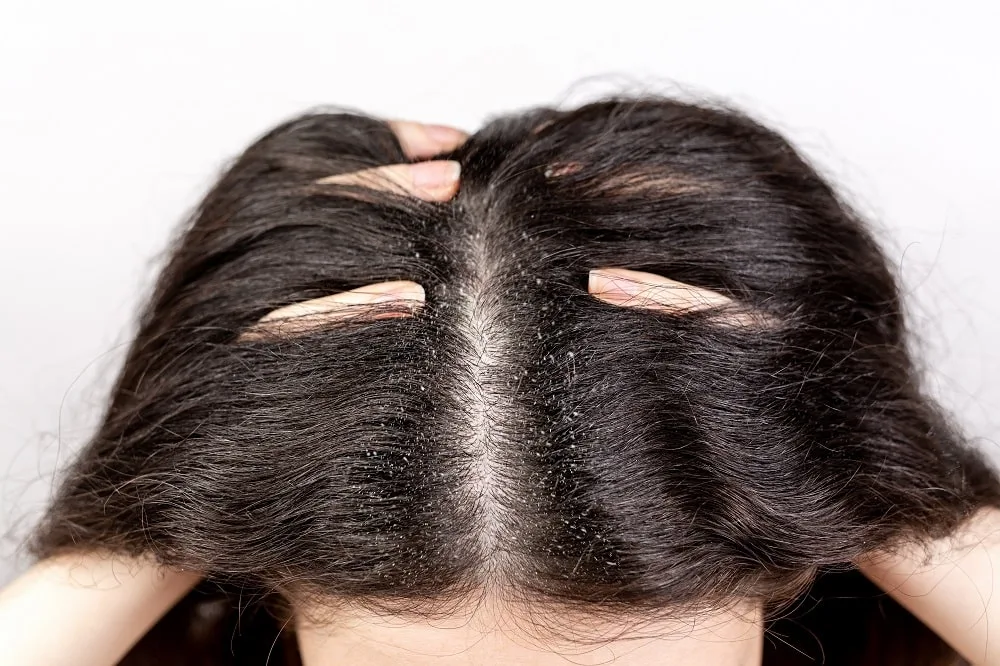
Product accumulation looks white and may appear scaly and in chunks. Sometimes the flakes resemble dandruff, but the build-up typically smells like the product you applied and leaves an oily residue on your fingers.
You may also notice tiny lumps of product in your hair, even after a wash. You probably have product build-up if you never seem to have clean hair or it feels lifeless and frizzy.
What Does Hair Build-Up Feel Like?
Run your hands through your hair if you have straight or wavy hair. You may have buildup if you feel a greasy film or rough clumps. Unless you have just oiled your hair, you should not feel grease in your hair.
For curly or kinky hair, take two fingers and run them over each curl or coil section – the smaller the portion, the easier it is to spot buildup. If you feel like your curls are unusually rough, that may be a product accumulation in your hair.
Another easy way to feel for buildup is to massage your scalp gently. You might have product buildup if you notice flakes, patches, roughness, or oil clumps. Also, if your hair feels matted, tangled, and breaks easily, you have product accumulation.
Your hair may feel dry but heavy. This ailment is a classic sign that product weighs down your hair, making it impossible for your strands to receive moisture. If you also feel like your hair is crunchy to the touch, like steel wool or toast, you should take steps to mitigate that.
What Causes Product Build-Up in Hair?
Product build-up in hair typically comes from ingredients that form a film over the hair. Examples include silicones, mineral oil, petroleum, waxes, butter, and heavy oils.
These ingredients protect against heat, UV, dust, wind, dry weather, and other factors. However, because they are not water-soluble, they do not wash off readily in the shower.
You may notice product buildup if you do not wash your hair often or with cleansing agents. Even if you use lightweight oils and water-based products, you will have product build-up if you rarely cleanse your hair.
Key Signs of Product Build-Up in Your Hair
Listen closely to what your hair needs. It will show you when the products have become too much. Watch out for these seven concrete signs that you have product build-up in your hair:
1. Greasy, Heavy, or Frizzy Hair
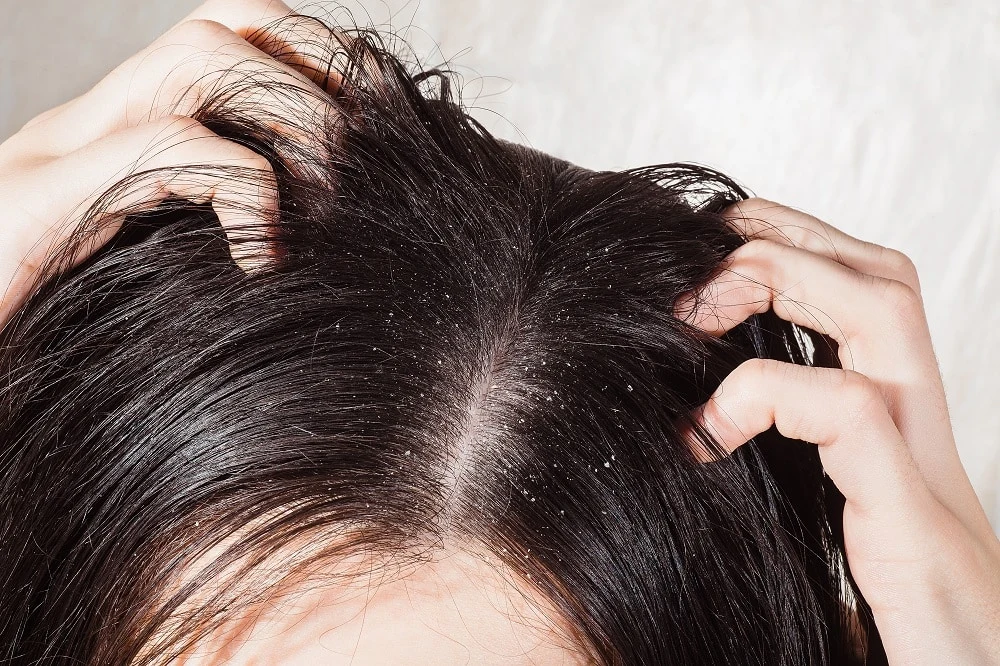
If your hair has this oily, heavy feel, even a day after shampooing, you may have product build-up. The products form such a heavy coating on your hair strands that one shampoo can’t get it out.
When products have heavily coated your hair, it will look dull. The greasiness of the hair causes a lackluster look plus a limp feel to the strands.
2. You’re Experiencing Scalp Discomfort
Scalp build-up does not just affect the hair strands but the scalp as well. The product will clog your scalp, making it inflamed and angry.
You will notice it itching more often and heavy flakes falling out. Your scalp is fighting the infection and buildup.
You’ll also notice that your scalp always feels greasy and never clean. Your hair, on the other hand, will feel dry and brittle.
This combination produces oily roots, an itchy scalp, and severely dry ends.
3. Your Curls Lose Their Oomph

You may notice a change in your curl pattern if you have naturally curly hair (type two to four). Your curls may lack definition, hold, and luster.
This is because buildup in curly hair makes it impossible for your hair to absorb moisture. Moisture is the defining factor for curly hair.
If your curly hair lacks moisture, it will appear frizzy or lumpy.
4. Your Hair Appears Flat and Becomes Unmanageable
You may notice that your roots always lay flat, even when you fluff them or style your hair with mousse. Additionally, your hair lacks elasticity and bounce and never holds a style.
The lack of moisture and nutrients due to a product build-up makes your hair lifeless and drab. Volume and definition require moisture, nutrients, and, more importantly, feather-lightness.
5. You Have Brittle & Dehydrated Hair

No matter how much you moisturize it or wear hydrating masks, your hair is forever dry and brittle. This inability to soak in moisture and much-needed nutrients comes from product residue.
Ironically, you need the masks, conditioners, and oils to make your strands strong and moisturized once more.
So you will find yourself caught in a cycle of putting product and never seeing results because you didn’t cleanse the product off correctly.
6. You Feel Like You Need to Shampoo More Often
Whatever your hair-washing schedule is, you may find that your hair never feels clean. You could even start washing more regularly, but your hair doesn’t feel clean.
Instead, your scalp may constantly feel greasy and itchy. Also, your hair feels weighed down, limp and heavy, even after a few hours.
This is because the buildup in your hair has caused your scalp to work harder to produce sebum to fight product remnants.
7. You Notice Severe Hair Breakage
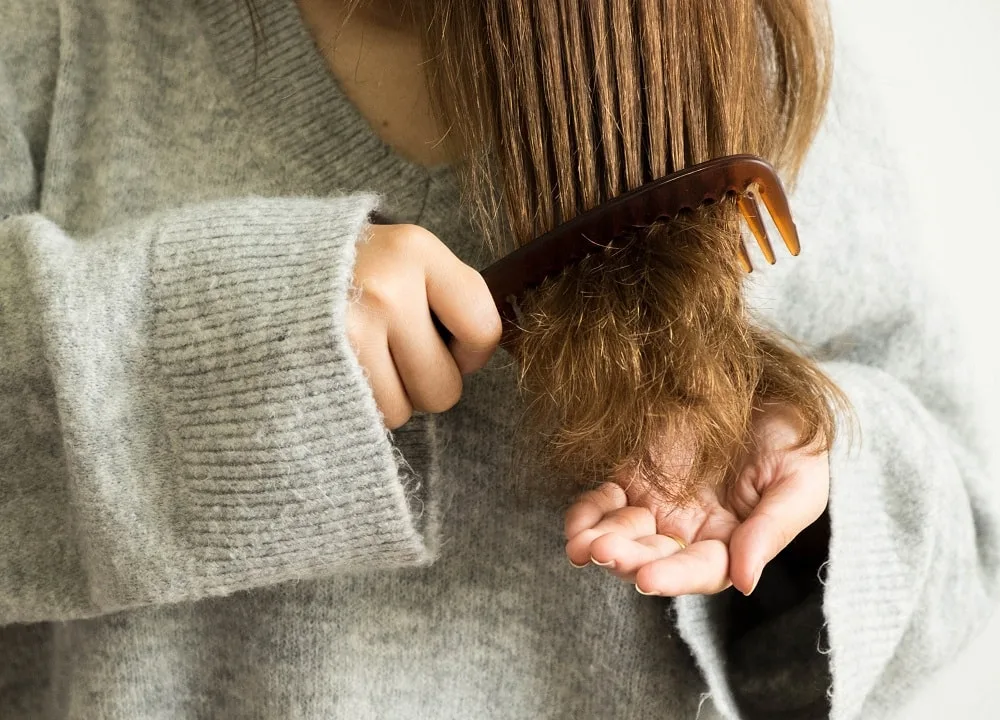
Severe hair breakage is not normal. Usually, it is a sign of an internal health issue or hormonal imbalance. However, sometimes the answer is as simple as product build-up.
The heavy weight of your strands, coupled with dry, unnourished hair, causes breakage. As a result, you’ll notice your mids to ends falling off rapidly, without any reason, and often.
How To Test for Hair Product Buildup at Home
You can test to see if your hair has product build-up using a few tests:
The Scalp Scratch Test
Part your hair and find a section. Then, carefully and gently scratch your scalp. If you notice any gunk or product under your fingernails, you likely have scalp build-up.
If you notice any grime or flakes from any of the above tests, it’s time to do something about the buildup in your hair.
The Hair-Feel Test
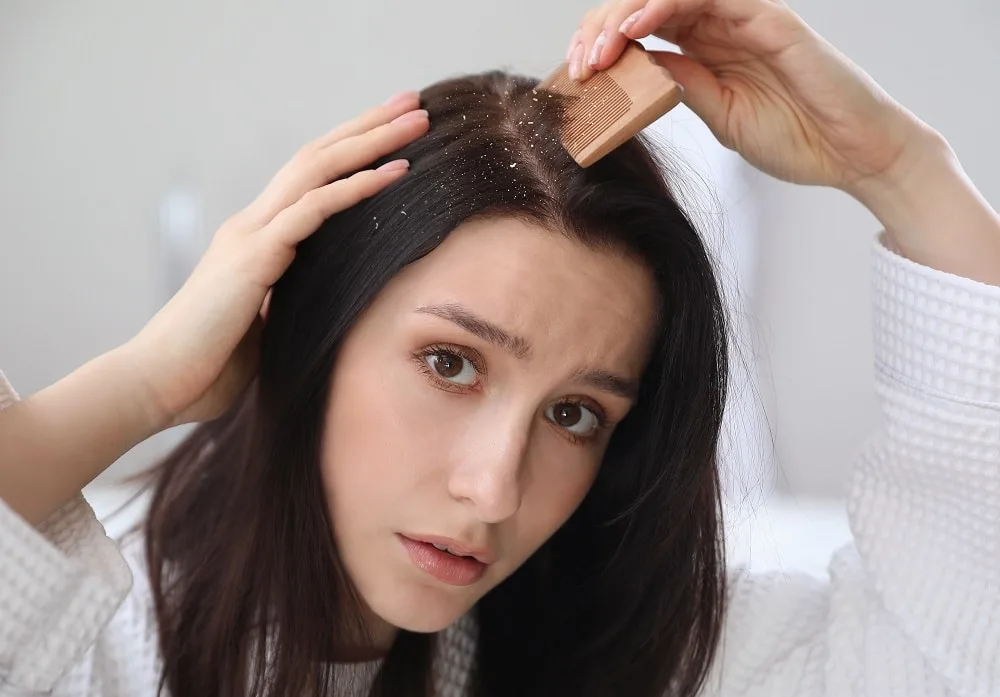
Part your hair into small sections. If you have straight hair, run your comb through a section. If the comb comes back with oils, gunk, or flakes, your hair has product build-up.
If you have curly hair, you can use a wide-toothed comb. Alternatively, you can run two fingers tightly from the root to the end of a section. You have remnants if your fingers come off with flakes, oil, or heavy grease.
How To Get Rid of Hair Product Buildup
There are four tried and proven ways you can remove buildup from your hair:
Clarifying Shampoo
Clarifying shampoos are a fantastic shampoo type to add to your hair routine. They strip the hair of any product or oil. Shampoo twice or thrice, depending on how much product you have built up. Then, be sure to follow with a moisturizing treatment or mask to replenish your hair.
Add a clarifying shampoo to your hair care routine as your hair needs. This will prevent product buildup from happening down the road. However, do not exclusively use a clarifying shampoo, as it can cause dryness.
Apple Cider Vinegar Rinse
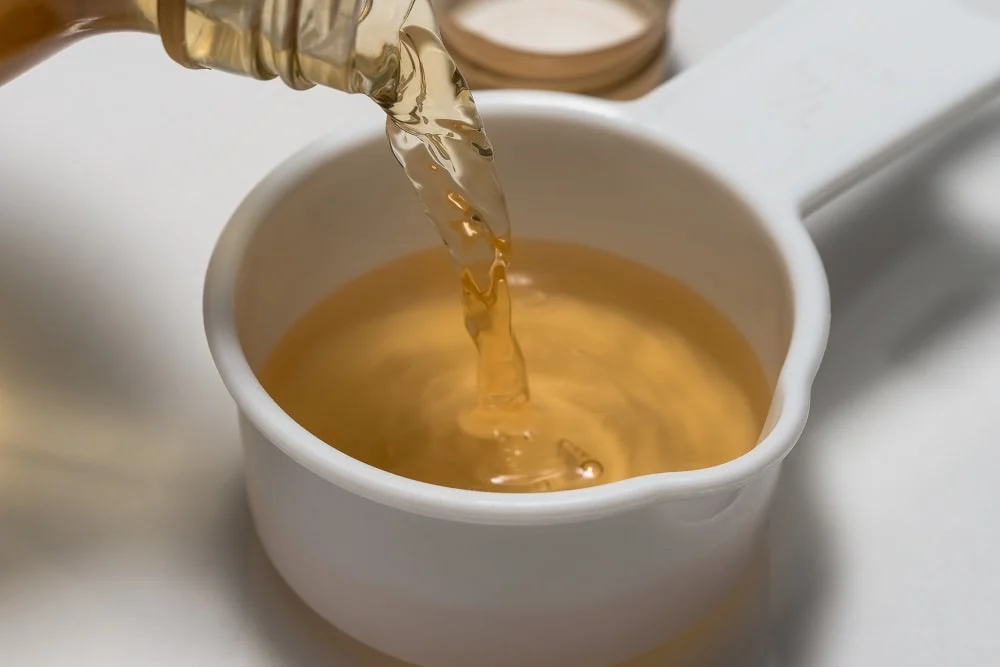
ACV has antimicrobial and cleansing properties. While it doesn’t immediately thoroughly cleanse, adding it to your weekly shampoo will do the trick.
Mix equal parts apple cider vinegar and water and pour it over your scalp and hair. Let it sit for 15 to 30 minutes, then rinse it.
Do this after shampooing for a few weeks and notice the difference. ACV also balances the pH of your scalp and hair, providing the ideal environment for hair growth.
Baking Soda Scrub
Many people swear by baking soda’s cleansing properties. Because it is highly alkaline, baking soda can lift off grime, dirt, and grease with ease.
Mix one tablespoon of baking soda with three cups of water and scrub your scalp and strands with it. If you need more, double or triple the mixture to cover all your hair properly. Rinse it off thoroughly and follow with a pH-neutralizing shampoo or conditioner.
Bentonite Clay
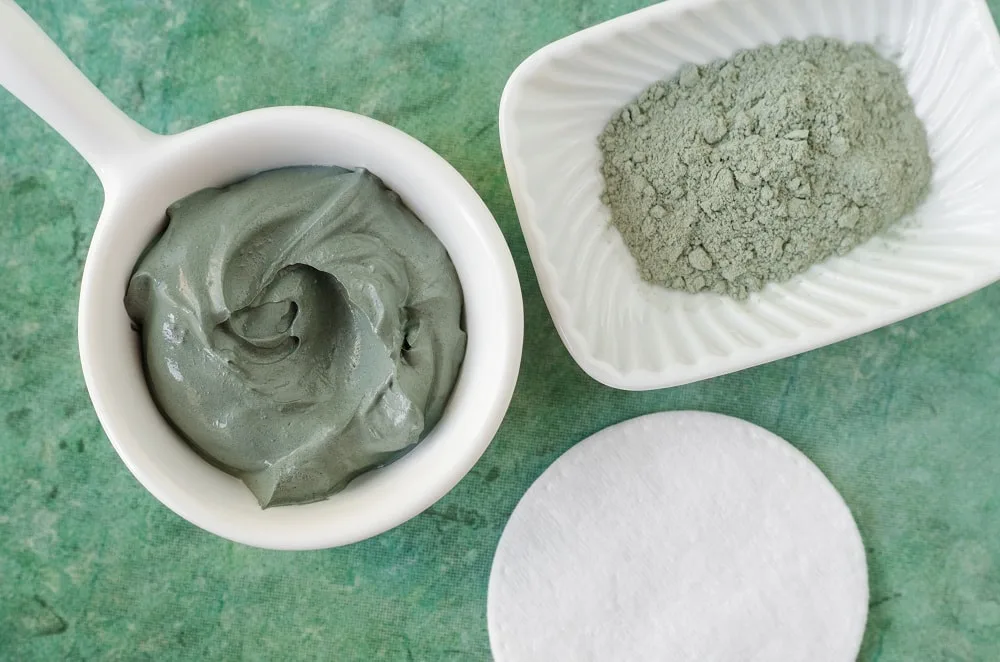
This clay is used by multiple communities around the world to cleanse hair. It is negatively charged and can draw impurities from skin and hair. Bentonite clay is an optimum cleanser for primarily curly hair.
Mix bentonite clay with ACV or water to form a paste. Apply the to your hair in sections, raking it through each strand. Let the clay sit and dry on your hair. Once it is completely dry, rinse it out thoroughly and follow with a moisturizing treatment. If you use hairspray regularly, read how you can get rid of hairspray buildup.
Can Product Build-Up Cause Hair Loss?
Yes, product build-up can cause hair loss. Due to the hair being coated heavily with products, it cannot absorb moisture or nutrients.
Dry and malnourished hair becomes brittle and prone to breakage. As a result, your hair will experience major breakage leading to patches, splits, uneven length, and even bald spots.
Conclusion
Hair product build-up can happen when you neglect proper hair washing and care techniques. It is not a helpless situation, and you can efficiently fix it. Take your time to clarify your scalp and hair regularly.
If your hair needs some extra TLC, try an ACV and clay mask to extract the buildup of oil and silicone in your hair. Ensure that you regularly clarify your hair and apply little, lightweight products to enjoy healthy, buildup-free hair.
FAQs on Product Buildup on Hair
Still have questions about product accumulation on hair? Here are some common queries about product buildup.
No, product buildup does not go away on its own. You have to make a conscious effort to rectify the situation by thoroughly cleansing your hair.
Yes, product build-up causes greasy hair. With several layers of product in your hair, your hair will look and feel greasy. Your scalp will also produce more sebum in response to inflammation, causing your hair to feel even greasier.
The safest way to remove scalp build-up from hair is by using a clarifying shampoo. They are made to safety standards to ensure your scalp and hair are squeaky clean. Other DIY methods can go wrong and lead to pH imbalance in your hair or over-stripped hair.
Yes, apple cider vinegar can remove buildup. However, it is not a one-time solution and requires repetitive use to see results.
Simply use apple cider vinegar, rinse once a week after shampooing, and leave it on for 15 minutes. Then, rinse it off and condition it. Over a few weeks, the apple cider vinegar will remove product buildup from your hair.
Yes, baking soda is a strong and effective cleansing agent. Due to its high pH, baking soda can lift dirt and grime from many surfaces, including hair. You can use a baking soda paste to wash your hair and remove product build-up.
Alternatively, you can add some baking soda to your shampoo before you emulsify and scrub your scalp with the mixture. Be careful to balance the pH of your hair afterward with a conditioner or hair mask.
